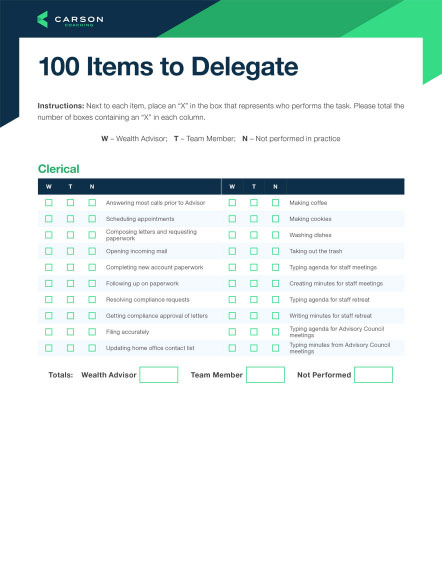One of the best ways to make improvements to your branding, client experience and value proposition is to get input from the experts – your clients.
As a Carson Coaching member, you know how we value client advisory council meetings. In fact, we see it as one of the best practices you can implement. We even built an entire course to give you a deeper dive into the subject.
The primary goals of implementing a client advisory council are to improve your branding (what do your clients think you do for them versus what you say you do), client experience (it gives your clients an understanding of what you do, and gives you insight into if they expect something from you that you’re not doing) and value proposition (is it the same as what your clients perceive it to be?).
But another residual benefit of client advisory councils is getting referrals.
Here’s where it gets tricky – you can’t have a client advisory council just to get referrals. That’s disingenuous, and will come across as such. The key is to deliver the best client advisory council experience first.
Remember the movie Field of Dreams? If you build it, they will come. Or in this case, if you build the client advisory council, the referrals will come.
Read more: An Introverted Financial Advisor’s Guide to Asking for Client Referrals
Crafting the Council
When choosing advisory council members, you’re looking for the clients you’d most like to replicate. That’s the baseline. You also want clients who you know will be participative and actively offer constructive feedback. You should also invite one or two centers of influence who you think would enjoy being on the council and could potentially provide referrals.
Using phrases like “I respect your opinion” or “I would love your advice” or “I really respect your opinion” when inviting clients to the advisory council will elevate your clients’ status in their minds and make them feel valuable. This will make it likely they’ll agree to serve a term on your council.
The term limits can vary from one year to 18 months to two years. If you have one-year or 18-month terms, you could have two meetings a year. If the terms are two years, you can have one meeting a year.
Some clients may want to stay on your council past their original term, but that’s your choice. It might not yield insightful results if you keep going back to the same people over and over again. It might be helpful to rotate in new people and get fresh perspectives.
Having Successful Meetings
So, about the meetings. Prepare ahead of time by sending members an agenda so they can think about and prepare for the topics.
During the meeting, use similar language to that you used when you invited them to the council. “I respect your opinion” and “I would love your advice” are great because people love giving their opinion and they love giving advice.
In the past, we’ve focused our guidance on holding lengthy in-person events, but now I actually recommend virtual events going forward. Virtual council meetings can be more focused and narrow – you can take an in-person event that was previously four to six hours and truncate it to an hour-and-a-half to two hours.
For example, instead of having a four-hour in-person meeting, you can have your first two-hour virtual meeting, then have another in two months and make tweaks to the event, report on what changes you’re making and reiterate what was said so you can ensure you’ve understood.
I think virtual events provide much more value than in-person events. I don’t have any members who have returned to doing live, face-to-face meetings yet.
Read more: The 4 Hows of Effective Referrals
Impact on Branding and Client Experience
When it comes to making a positive impact on your branding and client experience, client advisory boards have four major benefits:
- A clearer message to share. Most advisors think their clients know how to talk about them, and they don’t. Participating in a client advisory council gives your clients a very clear picture of what you do, which means they can better share your message with their friends and associates.When you have advisory council members who really get it because they were part of the discussion regarding your branding, they’re going to be able to share the message clearly.
- It gives them something to brag about. It feels good when somebody asks you to give advice on something important. That’s what serving on your client advisory council is going to do for your clients – it’s going to make them feel good. That’s when they’re going to start bragging to their friends about how their advisor asked them to be on an advisory council and actually listened to what they had to say.
- It makes them more impressed with what you do. When clients get a deeper dive into the inner workings of your firm and your decision-making process, they really start to get an understanding of how complicated it all is and how many layers you provide them in their client experience. As such, they’re ever more impressed with what you do.
- A clearer value prop. A client advisory council also helps you identify what your best clients think about your value proposition. I’ve had two firms that did value proposition work upfront and realized they were more than 50% off-track – meaning their client advisory council didn’t agree with half of what they were saying their value proposition was. This gave them an opportunity to realign their value proposition with their council’s perception of it. Now those council members are ingratiated to the firm owners because those owners listened and repositioned something in a way that resonated with them.
Read more: How to Get New Clients Now: The Prospecting Two-Step for Financial Advisors
One more step to consider: have a separate “thank you” event for members. This shows your council members that they’re respected, their opinion is appreciated and you’re listening to them and acting on what they’re saying.
One of my members put together a non-business social discussion as a thank you for his council members and got a referral from everybody at that lunch.
Preparing Them for the Inevitable
You have to prepare your client advisory council for the reality that you won’t be able to implement every idea or suggestion. We’re going to hear disparate recommendations, and not everybody is going to agree.
Say things like, “We’re going to take what you give us and see what we have the capacity for. So know that our intention is to use this information to make corrections.” Verbiage like this sets them up so they’re not offended when you don’t make all their suggested changes.
How you get the referrals ties into some of the things mentioned above: a clear message to share, something to brag about and clients being more impressed with what you do. Together, these three things make up the recipe for referrals from your advisory council members.
The Last Word
With client advisory councils, you’re constantly assessing your client service model, which can include things like technology expectations and frequency and type of communication, among other things.
But it can also be a self-generating referral machine as council members rotate, so you’re always bringing in new referral opportunities.
The primary benefit of a client advisory council is always to make your firm better, stronger and faster, but it doesn’t hurt that the secondary benefit is to get referrals from council members.


